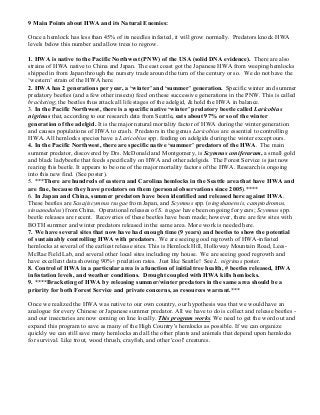
9 main points about hwa and its natural enemies
- 1. 9 Main Points about HWA and its Natural Enemies: Once a hemlock has less than 45% of its needles infested, it will grow normally. Predators knock HWA levels below this number and allow trees to regrow. 1. HWA is native to the Pacific Northwest (PNW) of the USA (solid DNA evidence). There are also strains of HWA native to China and Japan. The east coast got the Japanese HWA from weeping hemlocks shipped in from Japan through the nursery trade around the turn of the century or so. We do not have the ‘western’ strain of the HWA here. 2. HWA has 2 generations per year, a ‘winter’ and ‘summer’ generation. Specific winter and summer predatory beetles (and a few other insects) feed on these successive generations in the PNW. This is called bracketing; the beetles thus attack all life stages of the adelgid, & hold the HWA in balance. 3. In the Pacific Northwest, there is a specific native ‘winter’ predatory beetle called Laricobius nigrinus that, according to our research data from Seattle, eats about 97% or so of the winter generation of the adelgid. It is the major natural mortality factor of HWA during the winter generation and causes populations of HWA to crash. Predators in the genus Laricobius are essential to controlling HWA. All hemlocks species have a Laricobius spp. feeding on adelgids during the winter except ours. 4. In the Pacific Northwest, there are specific native ‘summer’ predators of the HWA. The main summer predator, discovered by Drs. McDonald and Montgomery, is Scymnus coniferarum, a small gold and black ladybeetle that feeds specifically on HWA and other adelgids. The Forest Service is just now rearing this beetle. It appears to be one of the major mortality factors of the HWA. Research is ongoing into this new find. (See poster). 5. ***There are hundreds of eastern and Carolina hemlocks in the Seattle area that have HWA and are fine, because they have predators on them (personal observations since 2005).**** 6. In Japan and China, summer predators have been identified and released here against HWA. These beetles are Sasajiscymnus tsugae from Japan, and Scymnus spp. (ningshanensis, camptodromus, sinuanodulus) from China. Operational releases of S. tsugae have been ongoing for years; Scymnus spp. beetle releases are recent. Recoveries of these beetles have been made; however, there are few sites with BOTH summer and winter predators released in the same area. More work is needed here. 7. We have several sites that now have had enough time (9 years) and beetles to show the potential of sustainably controlling HWA with predators. We are seeing good regrowth of HWA-infested hemlocks at several of the earliest release sites. This is Hemlock Hill, Holloway Mountain Road, Lees- McRae Field Lab, and several other local sites including my house. We are seeing good regrowth and have excellent data showing 90%+ predation rates. Just like Seattle! See L. nigrinus poster. 8. Control of HWA in a particular area is a function of initial tree health, # beetles released, HWA infestation levels, and weather conditions. Drought coupled with HWA kills hemlocks. 9. ****Bracketing of HWA by releasing summer/winter predators in the same area should be a priority for both Forest Service and private concerns, as resources warrant.*** Once we realized the HWA was native to our own country, our hypothesis was that we would have an analogue for every Chinese or Japanese summer predator. All we have to do is collect and release beetles - and our insectaries are now coming on line locally. This program works. We need to get the word out and expand this program to save as many of the High Country's hemlocks as possible. If we can organize quickly we can still save many hemlocks and all the other plants and animals that depend upon hemlocks for survival. Like trout, wood thrush, crayfish, and other 'cool' creatures.